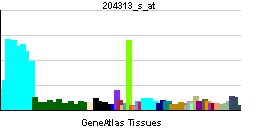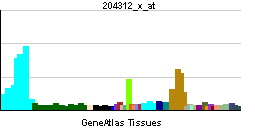CREB1
| Proteína de unión al elemento de respuesta de AMPc 1 | ||||
|---|---|---|---|---|
 Estructura tridimensional de la proteína CREB1. | ||||
| Estructuras disponibles | ||||
| PDB |
Lista de códigos PDB 1dh3
| |||
| Identificadores | ||||
| Símbolos | CREB1 (HGNC: 2345) CREB; MGC9284 | |||
| Identificadores externos | ||||
| Locus | Cr. 2 q33.3 | |||
| Patrón de expresión de ARNm | ||||
 | ||||
 | ||||
 | ||||
| Más información | ||||
| Ortólogos | ||||
| Especies |
| |||
| Entrez |
| |||
| Ensembl |
| |||
| UniProt |
| |||
| RefSeq (ARNm) |
| |||
| RefSeq (proteína) NCBI |
| |||
| Ubicación (UCSC) |
| |||
| PubMed (Búsqueda) |
| |||
El factor de transcripción CREB1' (de sus siglas en inglés "CAMP responsive element binding protein 1") es una proteína humana codificada por el gen creb1. Esta proteína reconoce y une el elemento de respuesta a AMPc, que consta de una secuencia de ADN presente en multitud de promotores virales y celulares. La unión de CREB1 estimula la transcripción de los genes controlados por estos promotores.
La proteína CREB1 pertenece al conjunto de factores de transcripción CREB, los cuales son miembros a su vez de la familia de proteínas de unión a ADN con cremallera de leucina. Esta proteína se une en forma de homodímero al elemento de respuesta a AMPc, cuya secuencia se conforma de un palíndromo octamérico. La proteína es fosforilada por diversas quinasas, e induce la transcripción de genes en respuesta a estimulación hormonal de la ruta del AMPc. El gen que codifica la proteína CREB1 puede sufrir splicing alternativo, generando dos transcritos que codifican diferentes isoformas de la proteína.[1]
Interacciones
[editar]La proteína CREB1 ha demostrado ser capaz de interaccionar con:
- HTATIP[2]
- RPS6KA5[3][4]
- CREBBP[5][6][7][8][9][10][11][12][13][14]
- FHL2[15]
- FHL3[15]
- p53[11]
- CEBPB[16]
- FHL5[15]
Véase también
[editar]Referencias
[editar]- ↑ «Entrez Gene: CREB1 cAMP responsive element binding protein 1».
- ↑ Gavaravarapu, S; Kamine J (Mar. de 2000). «Tip60 inhibits activation of CREB protein by protein kinase A». Biochem. Biophys. Res. Commun. (UNITED STATES) 269 (3): 758-66. ISSN 0006-291X. PMID 10720489. doi:10.1006/bbrc.2000.2358.
- ↑ Deak, M; Clifton A D, Lucocq L M, Alessi D R (Aug. de 1998). «Mitogen- and stress-activated protein kinase-1 (MSK1) is directly activated by MAPK and SAPK2/p38, and may mediate activation of CREB». EMBO J. (ENGLAND) 17 (15): 4426-41. ISSN 0261-4189. PMID 9687510. doi:10.1093/emboj/17.15.4426.
- ↑ Wang, X; Li W, Williams M, Terada N, Alessi D R, Proud C G (Aug. de 2001). «Regulation of elongation factor 2 kinase by p90(RSK1) and p70 S6 kinase». EMBO J. (England) 20 (16): 4370-9. ISSN 0261-4189. PMID 11500364. doi:10.1093/emboj/20.16.4370.
- ↑ Shi, Yuling; Venkataraman Sujatha L, Dodson Gerald E, Mabb Angela M, LeBlanc Scott, Tibbetts Randal S (Apr. de 2004). «Direct regulation of CREB transcriptional activity by ATM in response to genotoxic stress». Proc. Natl. Acad. Sci. U.S.A. (United States) 101 (16): 5898-903. ISSN 0027-8424. PMID 15073328. doi:10.1073/pnas.0307718101.
- ↑ Kim, J; Jia L, Stallcup M R, Coetzee G A (Feb. de 2005). «The role of protein kinase A pathway and cAMP responsive element-binding protein in androgen receptor-mediated transcription at the prostate-specific antigen locus». J. Mol. Endocrinol. (England) 34 (1): 107-18. ISSN 0952-5041. PMID 15691881. doi:10.1677/jme.1.01701.
- ↑ Shimomura, A; Ogawa Y; Kitani T; Fujisawa H; Hagiwara M (Jul. de 1996). «Calmodulin-dependent protein kinase II potentiates transcriptional activation through activating transcription factor 1 but not cAMP response element-binding protein». J. Biol. Chem. (UNITED STATES) 271 (30): 17957-60. ISSN 0021-9258. PMID 8663317.
- ↑ Radhakrishnan, I; Pérez-Alvarado G C, Parker D, Dyson H J, Montminy M R, Wright P E (Dec. de 1997). «Solution structure of the KIX domain of CBP bound to the transactivation domain of CREB: a model for activator:coactivator interactions». Cell (UNITED STATES) 91 (6): 741-52. ISSN 0092-8674. PMID 9413984.
- ↑ Sano, Y; Tokitou F; Dai P; Maekawa T; Yamamoto T; Ishii S (Oct. de 1998). «CBP alleviates the intramolecular inhibition of ATF-2 function». J. Biol. Chem. (UNITED STATES) 273 (44): 29098-105. ISSN 0021-9258. PMID 9786917.
- ↑ Zor, Tsaffrir; Mayr Bernhard M, Dyson H Jane, Montminy Marc R, Wright Peter E (Nov. de 2002). «Roles of phosphorylation and helix propensity in the binding of the KIX domain of CREB-binding protein by constitutive (c-Myb) and inducible (CREB) activators». J. Biol. Chem. (United States) 277 (44): 42241-8. ISSN 0021-9258. PMID 12196545. doi:10.1074/jbc.M207361200.
- ↑ a b Giebler, H A; Lemasson I, Nyborg J K (Jul. de 2000). «p53 recruitment of CREB binding protein mediated through phosphorylated CREB: a novel pathway of tumor suppressor regulation». Mol. Cell. Biol. (UNITED STATES) 20 (13): 4849-58. ISSN 0270-7306. PMID 10848610.
- ↑ Zhang, Q; Vo N, Goodman R H (Jul. de 2000). «Histone binding protein RbAp48 interacts with a complex of CREB binding protein and phosphorylated CREB». Mol. Cell. Biol. (UNITED STATES) 20 (14): 4970-8. ISSN 0270-7306. PMID 10866654.
- ↑ Ernst, P; Wang J, Huang M, Goodman R H, Korsmeyer S J (Apr. de 2001). «MLL and CREB bind cooperatively to the nuclear coactivator CREB-binding protein». Mol. Cell. Biol. (United States) 21 (7): 2249-58. ISSN 0270-7306. PMID 11259575. doi:10.1128/MCB.21.7.2249-2258.2001.
- ↑ Ledo, Fran; Kremer Leonor, Mellström Britt, Naranjo Jose R (Sep. de 2002). «Ca2+-dependent block of CREB-CBP transcription by repressor DREAM». EMBO J. (England) 21 (17): 4583-92. ISSN 0261-4189. PMID 12198160.
- ↑ a b c Fimia, G M; De Cesare D, Sassone-Corsi P (Nov. de 2000). «A family of LIM-only transcriptional coactivators: tissue-specific expression and selective activation of CREB and CREM». Mol. Cell. Biol. (UNITED STATES) 20 (22): 8613-22. ISSN 0270-7306. PMID 11046156.
- ↑ Chen, Yongchang; Zhuang Shunhui, Cassenaer Stijn, Casteel Darren E, Gudi Tanima, Boss Gerry R, Pilz Renate B (Jun. de 2003). «Synergism between calcium and cyclic GMP in cyclic AMP response element-dependent transcriptional regulation requires cooperation between CREB and C/EBP-beta». Mol. Cell. Biol. (United States) 23 (12): 4066-82. ISSN 0270-7306. PMID 12773552.
Enlaces externos
[editar]- MeSH: CREB1+protein,+human (en inglés)
